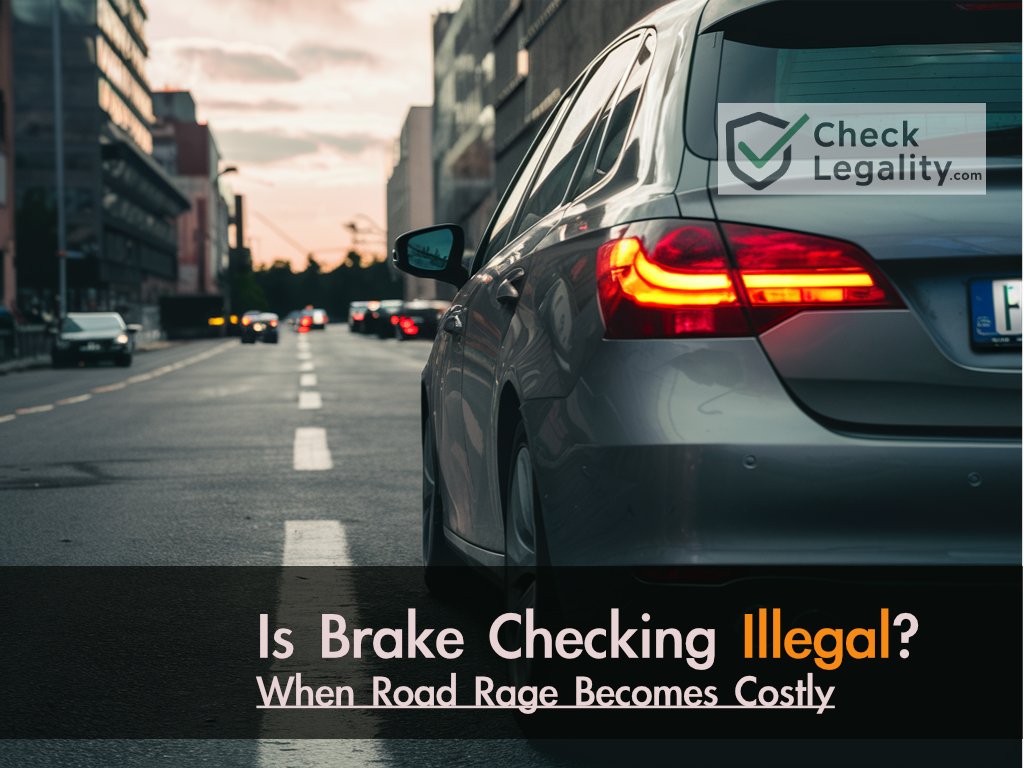Check Legality Summary:
Is Brake Checking Illegal? Yes, It’s Dangerous and Considered Reckless Driving
While brake checking might seem like a tempting response to a tailgater, it’s a dangerous maneuver that can lead to serious accidents and legal consequences. This article addressed the dangers of brake checking and explored the legal implications in different jurisdictions.
Here’s a quick recap:
- Brake checking is dangerous: Slamming on your brakes unexpectedly creates a risk of rear-end collisions for the driver behind you.
- It can escalate road rage: Brake checking can provoke aggressive behavior from the tailgating driver.
- It’s considered reckless driving: Many states have laws against reckless driving, which can encompass brake checking due to the disregard for the safety of others.
Read on to find out what your options are when someone brake-checks you or when you brake-check a tailgater.
Is Brake Checking Illegal? All You Need To Know!
You’ve been there. You’re cruising down the highway, the music is good, and the road ahead seems clear. Suddenly, you glance in your rearview mirror to see a pair of headlights looming much closer than you’d like. Your pulse quickens. Is this person just oblivious, or are they deliberately riding your bumper? The frustration builds. Maybe a quick tap on the brakes will send the message? But hold on – is brake checking illegal?
Dangers of Brake Checking:
Don’t do it! While the urge to brake check a tailgater might be tempting, it’s a dangerous reaction that can escalate a tense situation into a potentially disastrous one. A sudden and unexpected brake check can cause a rear-end collision, damaging both vehicles and occupants. Even if an accident is avoided, brake checking can trigger road rage, leading to aggressive driving maneuvers and further endangering everyone on the road.
Is Brake Checking Illegal? – Legal Ambiguity:

So, is brake checking illegal? Unfortunately, the answer isn’t straightforward. Traffic laws are primarily established and enforced at the state level, and there’s no single federal law that specifically outlaws brake checking. This lack of a clear-cut legal definition can lead to confusion, especially in the aftermath of an accident, when someone might claim, “They checked me!”
This article aims to shed light on the complexities surrounding brake checking. We’ll explore the dangers it poses, delve into the legal aspects considering state-by-state variations, and offer safe alternatives for dealing with tailgaters. We’ll also provide valuable information on what to do if you’re involved in a brake-checking accident and how to prove someone intentionally brake-checked you.
By understanding the consequences of brake checking and the importance of safe driving practices, we can all contribute to a calmer and safer driving environment for ourselves and others.
Understanding Brake Checking
A. Definition and Intent:
Brake checking, also sometimes referred to as “brake testing,” is the deliberate application of a vehicle’s brakes to force a following vehicle to slow down abruptly. It’s a dangerous maneuver distinct from normal braking used to slow down gradually in response to traffic conditions or upcoming hazards. The key element of brake checking lies in the intent behind the action. It’s not about slowing down safely; it’s about trying to punish or intimidate the driver behind you.
B. Risks and Consequences:
The risks associated with brake checking are significant and can have serious consequences. Here’s a closer look at some of the potential dangers:
- Rear-End Collisions: A sudden and unexpected brake check can catch the following driver off guard, leaving them with little time to react. This can lead to a rear-end collision, causing damage to both vehicles and potentially injuring occupants. If someone accuses you of brake checking and a collision occurs, the question of “Is brake checking illegal?” becomes a central issue in determining fault for the accident.
- Escalation of Road Rage: Brake checking can be a highly provocative action. The frustration you feel towards the tailgating driver might be reciprocated tenfold, leading to an escalation of road rage. The following driver might respond aggressively, attempting to swerve around you or retaliate with their own risky maneuvers, creating a chaotic and dangerous situation on the road.
- Loss of Control: A following driver surprised by a brake check might instinctively slam on their brakes or swerve to avoid a collision. This sudden maneuver could lead to a loss of control, potentially causing the driver to spin out or veer into oncoming traffic.
In essence, brake checking creates a chain reaction of unpredictable and dangerous situations. It’s important to remember that even if you avoid an accident, the act of brake checking itself is illegal in many states under reckless driving or aggressive driving laws.
Legality of Brake Checking: A State-by-State Analysis

A. Absence of a Universal Law:
Similar to tailgating, and unlike some traffic violations like speeding or running a red light, there’s no single federal law that explicitly outlaws brake checking. Traffic laws are primarily established and enforced at the state level. This means that the answer to the question “Is brake checking illegal?” depends on the specific laws of the state where the incident occurs.
B. Focus on Reckless Driving Laws:
While there might not be a law specifically addressing brake checking, most states have laws against reckless driving. These laws typically define reckless driving as operating a motor vehicle in a way that creates a substantial risk of serious bodily injury through intentional or willful disregard for the safety of others.
Here’s how brake checking can potentially fall under the umbrella of reckless driving:
- Intentional Act: Brake checking is a deliberate act of slamming on your brakes to force another driver to slow down abruptly. This intentional disregard for the driver’s safety could be interpreted as reckless driving.
- High Risk of Accidents: As discussed earlier, brake checking creates a high risk of rear-end collisions, swerving maneuvers, and potential loss of control. This increased risk of accidents due to your actions strengthens the argument for reckless driving.
Examples of State Laws:
It’s important to note that state laws can vary in their specific wording and interpretations. Here are a few examples to illustrate how different states might approach brake checking through reckless driving laws:
- California: California Vehicle Code (CVC) Section 22400(a) prohibits driving at a slow speed in a way that impedes the normal flow of traffic. While not explicitly mentioning brake checking, this law could be applied to situations where a driver intentionally slows down abruptly to harass a tailgater.
- Florida: Florida Statute 316.190(2)(b) defines reckless driving as operating a vehicle with willful or wanton disregard for the safety of persons or property. A judge might interpret a brake check as a willful disregard for the safety of the following driver.
This is not an exhaustive list, and it’s crucial to consult your state’s specific laws to understand how they handle brake-checking situations.
C. Is Brake Checking Illegal or Just Downright Aggressive?
Some states have additional laws against aggressive driving, which might encompass behaviors like tailgating, improper lane changes, and intentionally forcing other drivers off the road. While these laws typically don’t directly address brake checking, they can be used in conjunction with reckless driving laws to strengthen the case against someone who brake checked.
For instance, a state might have a law prohibiting drivers from intentionally swerving or braking to impede another vehicle. If someone brake-checks you and then swerves to avoid a collision, they might be cited for both aggressive and reckless driving.
D. “Is Brake Checking Illegal?” Case Law and Precedents:
In some “Is brake checking illegal?” cases, court decisions and legal precedents can play a role in interpreting how brake checking applies to existing traffic laws. Previous rulings on similar situations can influence how judges and law enforcement view brake-checking incidents.
Remember, the question of “Is brake checking illegal?” doesn’t have a simple answer. It depends on the specific circumstances of the incident and the laws of your state.
What to Do After a Brake-Checking Accident
Being involved in a brake-checking accident can be a stressful and confusing experience. Here are some crucial steps to take if you find yourself in this situation:
1. Ensure Safety and Call for Help:
The top priority is to ensure your safety and that of everyone involved in the accident.
- Turn on hazard lights: This will alert other drivers to the situation and prevent further accidents.
- Check for injuries: Call 911 immediately and request medical assistance if anyone is injured.
- Move your vehicle to a safe location: If possible, move your car to the side of the road or a safe off-ramp to avoid blocking traffic.
2. Secure the Scene and Gather Evidence:
Once the immediate danger has passed, it’s important to document the accident scene:
- Take pictures: Use your phone camera to capture photos of the damage to all vehicles involved, including skid marks on the road and any visible injuries.
- Note down details: Record the accident’s date, time, and location. If possible, take note of weather conditions and road visibility.
- Exchange information: Collect the name, contact information, and insurance details of the other driver involved in the accident. Avoid admitting fault or discussing the details of the incident beyond exchanging basic information.
3. Contact Your Insurance Company:
Report the accident to your insurance company as soon as possible. Provide them with all the details you have gathered, including pictures and notes from the scene. Cooperate with their investigation and follow their instructions regarding repairs or filing a claim.
4. Seek Legal Advice:
Consider consulting with an attorney specializing in car accidents, especially if you sustained injuries or the accident resulted in significant vehicle damage. A lawyer can advise you on your legal rights and options for pursuing compensation. They can also help navigate the complexities of accident claims, especially if the question of “Is brake checking illegal?” becomes a central point of contention.
In determining fault and potential compensation, the lawyer can analyze the evidence you’ve gathered, including witness statements (if available) and potentially police reports. They can also advise you on whether to file a claim against the other driver’s insurance company.
5. Importance of Police Reports:
While not definitive proof, a police report can provide a neutral record of the initial investigation and the statements of those involved. The officer’s observations of the scene, damage, and any witness accounts documented in the report can be valuable pieces of evidence, especially if the other driver disputes the events or denies brake checking.
By following these steps, you can protect your rights and gather the necessary information to navigate the aftermath of a brake-checking accident. Remember, staying calm, collecting evidence, and seeking legal advice can be crucial in such situations.
How to Prove Someone Brake Checked You
Being the victim of a brake check and subsequent accident can be infuriating. Not only were you subjected to a dangerous maneuver, but you’re now dealing with potential injuries, car damage, and the hassle of insurance claims. However, if you can prove the other driver intentionally brake checked you, it can significantly strengthen your case in holding them accountable. Here’s how to increase your chances of proving someone brake checked you:
A. Witness Testimony:
Securing statements from impartial witnesses who saw the brake-checking incident can be a powerful piece of evidence. Witnesses can provide first-hand accounts of the other driver’s actions and support your claim that they deliberately slammed on their brakes. Look for drivers in adjacent lanes or those who might have been behind the brake checker. Their testimony can help establish that your following distance was safe and that the other driver’s behavior was unexpected and dangerous.
B. Dashcam Footage:
Having a dashcam installed in your vehicle can be a lifesaver in such situations. Dashcam footage can provide irrefutable video evidence of the brake-checking incident. Ideally, the footage will clearly show the other driver’s abrupt braking, your car’s position with a safe following distance, and your inability to react in time to avoid a collision. If you’re considering getting a dashcam, look for one with a wide field of view that captures the road ahead and potential activity in adjacent lanes.
C. Event Data Recorder (EDR) Information:
Modern vehicles are equipped with Event Data Recorders (EDRs), also known as black boxes. These devices record various vehicle data points at the time of a collision, including speed, braking application, and sudden changes in acceleration. While EDR data may not explicitly show the intent behind the braking (i.e., whether it was a normal brake or a deliberate check), it can establish the sequence of events and potentially support your claim that the other driver applied the brakes abruptly.
However, accessing and interpreting EDR data typically requires the expertise of accident reconstruction specialists or law enforcement officials. Your lawyer can assist you in obtaining and analyzing this data to see if it strengthens your case.
D. Evidence of Prior Aggressive Driving:
If you can gather evidence of the other driver exhibiting aggressive driving behaviors before the brake checking incident, it can further bolster your argument. This might include witness statements about tailgating, improper lane changes, or other aggressive maneuvers shortly before the brake check. Such evidence can help paint a picture of the other driver’s overall reckless driving behavior, making the brake check seem less like an isolated incident and more like a pattern.
E. Inconsistent Statements from the Other Driver:
If the other driver’s statements about the accident contradict the evidence you have gathered or seem illogical, it can raise suspicion and support your claim of intentional brake checking. For instance, if they claim you were following too closely (which could be disproven by witness accounts or dashcam footage) or if they deny braking at all despite evidence to the contrary, these inconsistencies can work in your favor.
Challenges and Considerations:
- Burden of Proof: It’s important to understand that the burden of proof typically lies with the party filing a claim. In this case, you would need to present enough evidence to convince the insurance company or court that the other driver intentionally brake-checked you, causing the accident. While the evidence mentioned above can be helpful, it’s not always a guarantee.
- Shared Fault: Even if you can prove the other driver brake-checked you, there’s a possibility of a shared fault being assigned. For instance, if some evidence suggests you were following too closely, even though the brake check was the primary cause of the accident, you might be found partially responsible for the damages. The specific laws and fault determination procedures vary by state.
By gathering as much evidence as possible and consulting with an attorney specializing in car accidents, you can increase your chances of proving someone brake-checked you and holding them accountable for their actions. Remember, the more comprehensive your case, the stronger your position in seeking compensation for damages and injuries.
Conclusion and Recommendations
Recap:
Throughout this article, we’ve explored the dangers of brake checking, and have also answered the “Is brake checking illegal?” question from a different scope, the legal complexities surrounding its implications, and the importance of safe driving practices. We’ve also discussed the steps to take after a brake-checking accident and the challenges of proving someone intentionally brake checked you.
It’s crucial to remember that we all share the responsibility of creating a safe and courteous environment on the road. Brake checking is not only dangerous but can also lead to legal and financial repercussions. By choosing to be a responsible driver and avoiding impulsive maneuvers like brake checking, we can significantly reduce the risk of accidents and road rage incidents.
Recommendations for Drivers:
Here are some clear recommendations for drivers to avoid brake checking and handle tailgating situations safely:
- Maintain a safe following distance: Leave ample space between your vehicle and the car in front of you to allow for reaction time in case of sudden braking. A good rule of thumb is the three-second following distance rule.
- Move over if safe to allow tailgaters to pass: If you feel uncomfortable with a car following too closely, check your surroundings and consider moving over to another lane if it’s safe to do so. This can help defuse the situation and avoid escalating tensions.
- Avoid engaging with tailgaters through gestures or aggressive maneuvers: Don’t respond to tailgating with angry gestures or brake lights. This can further provoke the other driver and increase the risk of an accident.
- Practice defensive driving techniques: Stay alert, be aware of your surroundings, and anticipate potential hazards. Defensive driving techniques can help you react calmly and safely to unexpected situations on the road.
- Consider a Dashcam: Investing in a dashcam can provide valuable video evidence in case of an accident and potentially help you prove a brake checking incident
Remember, by practicing safe driving habits and avoiding impulsive reactions, we can all contribute to a safer and more pleasant driving experience for ourselves and others. Getting to your destination safely should always be the top priority.


